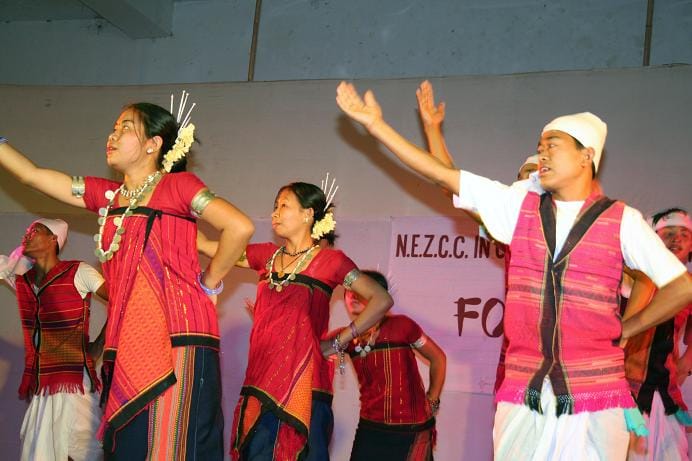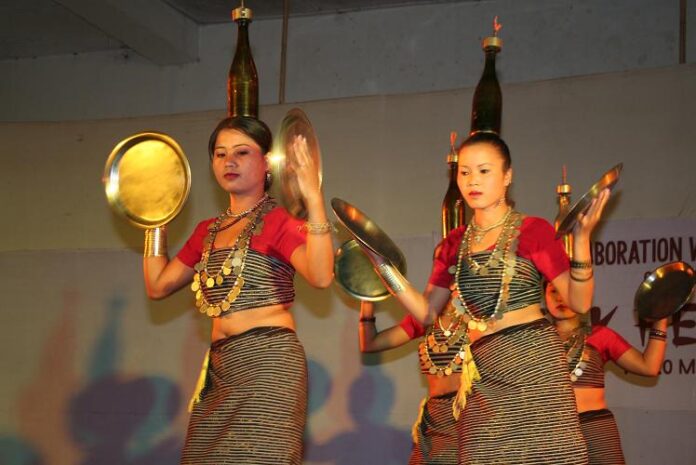Tripura is a small but strategically important state of the Northeast. Tripura is also mentioned in the Mahabharata and the Puranas. There is a difference of opinion among scholars regarding the name ‘Tripura’. Many myths and legends are prevalent regarding its origin. It is said that Tripura got its name from the goddess Tripurasundari in Udaipur. It is a common belief that the state derives its name from “Tripurasundari”. Tripurasundari is the patron goddess of this land. It is considered one of the 51 Shakti Peethas of the Hindus. This temple located in Udaipur of Gomti district was built by Maharaja Dhan Manikya in 1501 AD. There is another opinion that this state got its name Tripura due to being the land of three cities.

A section of scholars believe that it was named Tripura because it was the kingdom of the mythical king Tripura. Some scholars are of the opinion that the word ‘Tripura’ is a distorted form of two tribal words ‘Tui’ and ‘Pra’ which literally means ‘land near water’ (tui-jala, pra-near). The corrupt form of Tui-Pra has become Tripura and the corrupted form of Tipra has become Tripura. According to the ‘Rajmala’ the rulers of Tripura were addressed by the surname “Fa” which means father. The early history of Tripura especially in the 15th century The history before the 1st century is not clear. The early history of Tripura is made up of legends and speculations which cannot be trusted with much.
The rulers of Tripura had to face repeated invasions by the Mughals. The reign of Maharaja Virchandra Kishore Manikya Bahadur ushered in a new era in Tripura in the 19th century. His successors ruled Tripura till 15 October 1949. Thereafter it Joined the Union of India. Tripura was an ancient Hindu state and was ruled by Maharajas for 1300 years before its merger with the Union of India on 15 October 1949. Tripura was made a Union Territory on 01 September 1956 following the reorganization of states. Answer According to the former Reorganization Act 1971, it was given full statehood on 21 January 1972.
Nineteen tribal groups make Tripura’s society diverse, the main ones being Tripuri, Reang, Noatia, Jamatia, Chakma, Halam, Mog, Kuki, Garo, Lushai, Santal, Bhil, Khasia, Munda etc. Apart from the tribals, Bengali and Manipuri people also live here. Out of the nineteen tribes of Tripura, there are five major ones which are given the noun of “Panch”. The tribals of Tripura can be divided into two categories – 1. Natives 2. Immigrants. Tripuri, Reang, Jamatia, Noatia and Halam communities are the original inhabitants here who are called ‘Panch’. Munda, Orang, Santhal, Lepcha, Khasia, Bhutia, Naga, Lushoi, Uchai, Chamal, Kuki , Garo, Mog, Chakma are the immigrant tribes of this region who settled here from other regions of India in different periods due to various reasons.
Most of the tribes in Madhya Pradesh, Bihar, Odisha, P. They have settled here from Bengal. Some tribes have also come from Bhutan, Meghalaya, Mizoram, Sikkim, Manipur. In terms of religion, most of the tribals of Tripura follow Hinduism. People of Kuki and Lushai community follow Christianity while The Chakma and Mog communities follow Buddhism. This region has rich cultural heritage, rich tradition, unique store of folk festivals and folk colors. Dance is an integral part of the lifestyle of the tribals of Tripura. There is considerable variation in the dance styles of different communities.
Most of the dances are performed on the occasion of festivals. Instruments made of bamboo, cymbals, khamb, flute etc. are used in the dance. The main folk dances of Tripura are- Hojagiri dance of Reang community, Garia, Jhoom, Mamita, Masak. Lebang Boomani dance of Sumani and Tripuri community, Biju dance of Chakma community, Cheraw and Welcome dance of Lusai community, Wangla dance of Garo community, Sangraika, Chimithang, Padisha and Abhangma dances of Mog community, Garia dance of Jamatia community, Bengali community dance Gajan, Dhamail Sari and Rabindra dance and Basant Ras dance of Manipuri community. Each community has its own traditional musical instruments, some of which are Khamb (drum), bamboo flute, lebang, sarinda, dotara, khengrong etc.
Garia Dance-Tripuri community worships Lord Garia in the month of Chaitra for a good harvest. Through this dance, efforts are made to please their gods and goddesses. Both men and women participate in it. Life of the Tripuri community is vibrant. revolves around farming. When the sowing of seeds on a plot of land selected for Jhum is over by the middle of April, prayers are offered to Lord Garia for a good harvest. The festivities associated with Garia Puja last for seven days. Efforts are made to please their favorite deity with song and dance.
After the Lebang Boomani Nritya-Garia festival is over, the Tripuri community has enough time to wait for the monsoon. During this period attractively colored insects called lebangs move to the hill slopes in search of the sown seeds. The men make a peculiar rhythmic sound with two bamboo splinters in their hand while the women catch insects called ‘lebang’ on the hill slope. The rhythm of the bamboo sound attracts these insects and the females catch them. Due to change in time jhum cultivation is gradually decreasing. In both the dances Tripuri community use instruments made of bamboo like Khamb, Bansuri, Sarinda, Lebang made of bamboo.
Hojagiri Dance- Hojagiri is the main folk dance of Reang community. There is no movement of hands or upper body in this dance. Emotions are conveyed by movement of limbs from waist to feet. The theme of the dance is almost same as in other tribes. But the dance form of Reang community is quite different from others. The movement of the hands or even the upper body is somewhat restricted while the movement starting from their waist down to their feet creates a wonderful wave. Standing on an earthen pot with a bottle on the head and a lighted lamp on it, the audience is mesmerized when the Riang dancers rhythmically move the lower part of the body while dancing. The people of the Reang community use musical instruments made of bamboo like bamboo pole, flute.
Biju dance – This dance is a popular dance of the Chakma community. The meaning of Biju is ‘Chaitra-Sankranti’. ‘Chaitra-Sankranti’ marks the end of the Bengali calendar year. During this period the Chakmas sing songs and bid farewell to the past year as well as welcome the new year.
Hay-Hak Dance- Hay-Hak is the main dance of Halam tribe. Hai-Hak dance of Halam community is related to agriculture. This dance is presented in the prayer of Mata Lakshmi after sowing in the fields. Other tribal communities of the state Like other communities, the social and economic life of the Halam community also revolves around jhum cultivation. This festival is traditionally held at the end of the harvesting season to please Goddess Lakshmi. They enjoy this festival with the popular Hay-Hak dance. It is a community dance. The heritage of the past is reflected in this dance.
Wangala Dance – After a good harvest, the ‘Vangala’ (first rice eating ceremony) festival is celebrated in every household. In this festival, the heads of the communities go to every house and cut pumpkins. Pumpkin cutting is an essential ritual of this festival. There is a very ancient tradition of sacrificing pumpkin on this occasion. After that the women dance to the tune of ‘Dama’ and ‘Aduri’ made of buffalo horn. This is a war dance.
Welcome Dance – The welcome dance is performed by the girls of Lusai tribe of Tripura on the arrival of the guests. Girls wearing colorful clothes and wearing flowers in their hair dance in front of the special guest. For this dance Lusai girls They are well prepared. Whenever a visitor visits their house, they perform a welcome dance. It is a colorful dance of the Lusai tribe in which young girls from the entire community participate. His dress is so colorful that there is no need for ornaments except fragrant flowers.
Cheraw dance – The people of Darlong community believe in reincarnation. They believe that after death man is destined to go to heaven. They think that if a pregnant woman dies, she finds it difficult to make the long journey to heaven. So in the last stage of her pregnancy in real time or immediately before delivery all her relatives perform cherva dance in group day and night to instill confidence in the mind of that woman. They strongly believe that even if the woman dies at this point, it will be possible for her to go to heaven with courage and confidence.
Sangrai Dance- Sangrai dance is performed by the people of Mog community on the occasion of Sangrai festival in Chaitra month of Bengali calendar year. Young boys and girls of the Mog tribe participate in this dance and express their thoughts through cultural programs on the occasion of New Year.




